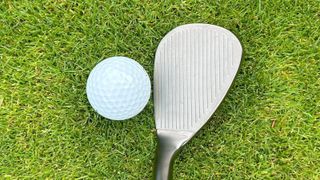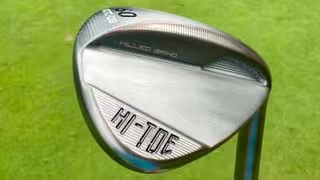TaylorMade spearheaded the movement towards full-face grooves back in 2017 and four generations of Hi-Toe wedges later, the brand has released the Hi-Toe 4 wedge that looks to offer maximum versatility and performance. In order to see if the refinements have improved on its predecessor, the Hi-Toe 3 wedge, I took the new short-game offering out onto the golf course and put it through its paces, testing it from a variety of lies and distances.
WATCH: We run through the most forgiving wedges of 2024
First up, I love how clean the new TaylorMade Hi-Toe 4 wedges look. The refined aesthetics almost give this wedge a ‘prototype’ visual. I could see how some people would say it almost doesn’t look finished due to the large clear space on the back but this is a change I like. The copper finish is something that has remained consistent throughout all of the TaylorMade Hi-Toe models and the Hi-Toe 4 is no exception. This finish, alongside the raw face, helps reduce glare on sunny days and is a finish many tour players love.
TaylorMade Hi-Toe 4 Wedge
(Image credit: Future)
The Hi-Toe 4 has the bottom groove filled with golf paint which has been designed to help with alignment, alongside the reduced offset found on the Hi-Toe 4 models. While I can’t say the offset was overly noticeable, I did appreciate how the colored groove helped me align the face to my target. These wedges are available in lofts from 50° through to 60° although the full-face grooves only feature in lofts of 54° and upwards.
The face and groove pattern is the same as those found on the TaylorMade MG4 wedges – considered among the best wedges for spin control, certainly from our testing. I can’t say I’m a massive fan of the overall shape of the head and personally I prefer a slightly straighter leading edge, like that found on the Titleist Vokey SM10 or Ping S159 wedges, but that’s a matter of personal preference.

The TaylorMade Hi-Toe 4 Wedge has full face grooves and a rounded leading edge
(Image credit: Future)
While the cosmetics of this wedge can be seen to help with the performance, the main storyline with the Hi-Toe 4 wedges is how versatile they are. The Spin Tread technology on the face meant that I saw really high levels of spin and control not only from the fairway but also from the rough. Laser etching is used to help repel water from the clubface, creating more friction with the grooves and the ball and therefore resulting in more spin and this is something I really…
..
Click Here to Read the Full Original Article at Golf Monthly…
